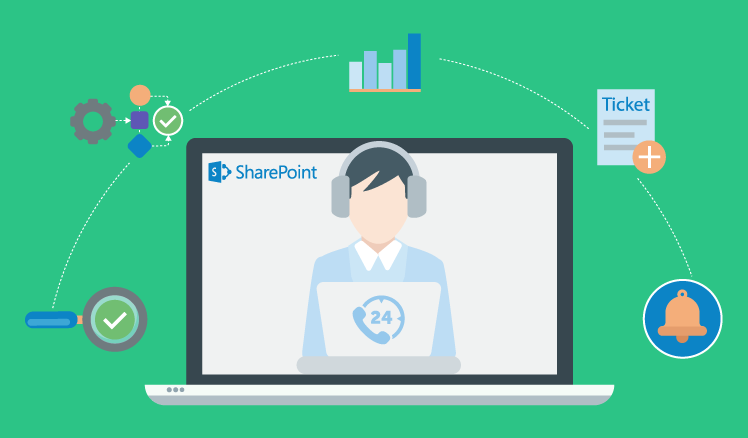Why and how to implement a ticketing system with SharePoint
The main purpose of a ticketing system is to assist in solving problems not causing new ones. Keeping that in mind, many enterprises shy away from introducing new software to their digital environment as they fear compatibility issues.
Good news is that they don’t need to buy and deploy third-party ticketing software. Actually, they can build a ticketing system on the software they already use.

Enterprise-scale ticketing with SharePoint
85% of Fortune 500 companies use SharePoint for employee collaboration, document management, project management, etc., so it makes sense to consider this popular content management and collaboration platform as a basis for a ticketing system. Here are the reasons why it can be a good idea.
To begin with, SharePoint is a customization- and integration-friendly platform. It can help to build a ticketing system tailored to the needs of the whole enterprise or its separate departments. Thus, a SharePoint ticketing system is suitable for processing requests of various types, such as:
- HR – vacations, sick leave, training, etc.
- IT – user support, network issues, user access issues, intranet support (permissions, tutorials, errors), etc.
- Accounting & finance – expense approvals, invoices, payment tracking, etc.
- Legal – requests on reviewing, approving, certifying documents, etc.
- Purchasing – purchase requests, quote requests, etc.
- Security – security check requests, audit requests, etc.
- Office support – office supplies, printing and courier services, etc.
- Facilities support – facility repair, booking equipment or meeting rooms, etc.
- Customer/after-sales service – issues with services or products.
Customization capabilities
To offer robust ticketing to businesses, the SharePoint platform should be customized. Depending on time and effort requirements, we distinguish two types of customization for a ticketing system based on SharePoint:
- Type A – easy customization, it doesn’t require much time (around 16-32 hours/feature) and effort. However, it requires more technical skills than that of an admin who handles the configuration of out-of-the-box features of SharePoint.
- Type B – complex customization, it may require 32-160 hours/feature, and a highly qualified specialist is needed for the job.
Let’s see what capabilities these two customization types can add to a SharePoint ticketing system.
Type A: Slight customization
This kind of customization can be enough for tasks in HR, IT, and office support. With Type-A customization, a SharePoint ticketing system offers:
- Creating request forms containing a requestor’s name, contacts, department, location, etc.; a request title, category, type, priority, related item (in case of integration with an asset management system), due date, etc.
- Attaching a file or a signature to a ticket.
- Tagging employees for getting a request approval.
- Creating anonymous tickets.
- Prioritizing tickets.
- Organizing tickets into groups: new, important, resolved, etc.
- Color marking of top priority, due issues and statuses.
- Changing a logo, a background picture, a color theme (branding).
- Building a knowledge base to address the most repetitive issues.
Type B: Deep customization
This kind of customization can be suitable for highly regulated domains, such as law, finance, and security, where the role of notifications and analytics is critical. With deep customization, a SharePoint ticketing system can get more advanced capabilities:
- Managing tickets, assignees & watchers. A deeply customized SharePoint ticketing system allows generating tickets from email. It also offers to insert screenshots into request forms, duplicating and modifying tickets to create new tickets on their basis. Profound customization enables the automated assigning of issues to operators based on matching competences shown in user profiles, indicating estimated time for ticket execution, tagging watchers and tracking execution times. With Type B customization, it’s possible to merge, group, reassign, forward, print out (PDF is generated) tickets, etc. Also, a customized SharePoint ticketing system provides automated suggesting ticket resolution templates to assignees based on issue tags and related knowledge base articles.
- Notifications. Deep customization enables a SharePoint ticketing system to support notification templates, such as ticket creation or assigning, replies, etc. Besides, it allows for automated generating notifications about new tickets assigned, user replies, ticket changes, upcoming or expired due date, SLA breaches, etc. It also enables direct replying to notifications with the automated turning of replies into discussion comments.
- Integrations. Type B customization provides integrating a SharePoint-based ticketing system with other software. For example, such integration with an intranet allows for extracting user profile info from an intranet to request forms. Integration with CRM (Zoho, Hubspot, Salesforce, etc.) facilitates work for customer service as it becomes possible to extract a customer’s profile and account information, service history, etc. the moment a customer has filed a complaint. Integration with ERP systems and databases provides a synchronized data flow between these systems without duplicating data entry. Also, integrating a SharePoint ticketing system with an asset management system helps to associate tickets to physical items, check their availability, cost, description, etc. and to pull items to the item catalog.
Ready-to-go SharePoint ticketing solutions
Apart from customization, companies can opt for ready-to-go SharePoint-based solutions. Let’s have a look at popular SharePoint ticketing products and their benefits and drawbacks.
IT Help Desk by Crow Canyon Systems
Pros
The tool is available on mobile devices and enables 24/7 support. IT Help Desk offers integration with email and asset management systems. It’s easy to manage, as it uses standard SharePoint utilities as well as a custom administrative interface for easy configuring and maintaining the system. The tool supports priority filters that allow identifying deadlines and overdue tickets quickly. IT Help Desk has extensive reporting capabilities, including visual displays of ticket status, assignment, quantity, priority, resolution time, etc. What’s more, the ticketing tool can use Power BI to generate reports.
Cons
IT Help Desk requires IT team assistance for installing. This ticketing tool doesn’t offer real-time chats, multi-channel communication or multilingual support. Also, the Standard plan of IT Help Desk has limited functionality. For example, it doesn’t support external user management (creating tickets, viewing and modifying them, etc.) and SLA management.
MetaCaseDesk by MetaOption
Pros
MetaCaseDesk offers two separate portals for end-users (Customer Portal) and support team (Support User Portal). Customer Portal allows users to log into a secure SharePoint website and report or track incidents and cases. Support User Portal allows users to log in, create, manage and track tickets. MetaCaseDesk provides 24/7 live support and can be integrated with asset management and email systems. The tool enables multiple authentication modes and supports various user roles: end-user, end-user admin, support user (read-only), support user (read/write), and support user admin. Also, MetaCaseDesk allows for SLA configuration and notifications and provides multi-channel communication.
Cons
This ticketing tool is not available on mobile devices. Also, it doesn’t offer community forums and multilingual support.
Help Desk Plus by Ivero
Pros
Help Desk Plus allows creating an unlimited number of different request templates (IT request, purchase request, HR request, etc.). The tool enables access management based on three levels of users: Employees, Administrators, and Technicians. It also supports customizable email notifications and request form fields. What’s more, the tool provides adding multiple attachments and comments to requests.
Cons
Help Desk Plus provides only basic ticketing functionality.
SharePoint HelpDesk by Plumsail
Pros
SharePoint HelpDesk offers easy and fast installing, which can be done without IT team’s assistance. The tool has a mobile version. It’s also user-friendly: for example, all emails go directly to HelpDesk, and users just need to assign and resolve tickets. Also, SharePoint HelpDesk supports customization of ticket views, templates, forms, reports, statuses, look and feel. It also facilitates managing large amounts of tickets due to merging or splitting them. The ticketing solution by Plumsail offers external user support allowing customers to create tickets, view and modify them, and see all information about submitted tickets from any external site with the help of a special web-based Widget. What’s more, SLA management is included in all payment plans.
Cons
24/7 support is not available with SharePoint HelpDesk. Also, the tool has poor interoperability with Office 365 email systems.
Benefits & limitations
Either as a customized or a ready-to-go solution, SharePoint can become a productive ticketing and helpdesk tool. However, before opting for this platform to build a ticketing system, it’s crucial to analyze pros and cons of SharePoint ticketing.
Benefits
- User familiarity for people who already use SharePoint or Office 365.
- Extensive customization & integration capabilities that allow for adapting a ticketing system to a customer’s business needs.
- Improved user experience due to single sign-on with other Microsoft products.
- 24/7 accessibility as it’s available on all devices (PC, laptops, smartphones and tablets).
- Solid security provided by such features as data encryption, user permission levels, multi-factor authentication, strong passwords, etc.
- Automated workflows for approvals, delegations, notifications, email alerts and escalations of requests.
- Advanced search by metadata and full text.
- Fully-fledged reporting & analytics with data visualization (dashboards).
- Cost-effectiveness even for small businesses as subscription plans start at $5.00.
Limitations
SharePoint out-of-the-box functionality for ticketing is limited. Without customization, SharePoint can meet only basic business requirements to ticketing and helpdesk. The platform needs significant customization to enable notifications, attaching files to request forms, etc. Also, SharePoint has no analytical tool of its own and should be integrated, for example, with Power BI. Such integration is not a problem from a technical side but not cost-effective.
Also, SharePoint doesn’t support multilingual user interface and content of sites out of the box. Starting from September 2018, the Machine Translation Services are being deprecated in SharePoint Online, and Microsoft recommends to use Bing translation APIs for that purpose.
Another pain point is multichannel communication. SharePoint doesn’t support automated generating tickets from Facebook or Twitter messages and posts.
Is there an alternative?
In case lots of customization is not for you, among other platforms, we recommend building your ticketing solution on Microsoft Dynamics 365. Microsoft offers Dynamics 365 Customer Service, a dedicated product that can serve equally well as a customer support ticketing system and a help desk app for employees. Dynamics 365 Customer service doesn’t require substantial customization, and even its basic pricing plan provides rich ticket management, knowledge management, SLA management, and reporting functionality. With Dynamics 365 Customer Service, you can easily streamline your help desk workflows and improve the productivity of your support agents.
On a final note
A SharePoint-based ticketing system can become a valuable asset to companies that already use SharePoint Online or Office 365, as they can avoid integrations with third-party systems. This helps companies to maintain an integral digital working environment and reduce costs. However, building a feature-rich ticketing or helpdesk system based on SharePoint may require resource- and time-consuming customization.

